Exploring the outdoors alone has become a transformative experience for many adventurers. In 2025, solo hiking continues to rise as a popular way to connect with nature and oneself. This guide highlights trails that balance adventure with safety, ensuring a rewarding journey for independent explorers.
Trail popularity, infrastructure, and community support play a crucial role in shaping recommendations. For instance, the South West Coast Path in England is celebrated for its scenic beauty and safety, while the Isle of Skye offers well-marked trails despite challenging weather conditions. These destinations provide both adventure and peace of mind.
Modern solo hikers benefit from innovative gear and navigation tools. Carrying a spot beacon or satellite phone ensures safety, while proper footwear minimizes discomfort. Mental preparedness is equally important, as staying positive and resilient enhances the experience.
From Patagonia’s W Trail to the Blue Mountains in Australia, these trails offer diverse landscapes and rewarding views. Whether you’re seeking solitude or camaraderie, solo hiking in 2025 promises unforgettable adventures.
Table of Contents
Key Takeaways
- Solo hiking is a growing trend for 2025, offering mental and physical rewards.
- Trail popularity and infrastructure are key factors in choosing safe routes.
- Essential gear like spot beacons and proper footwear enhances safety and comfort.
- Mental preparedness is crucial for overcoming challenges on the trail.
- Community support often fosters camaraderie among solo hikers.
Why Solo Hiking is the Ultimate Adventure
Stepping onto a trail alone can unlock a world of self-discovery and freedom. For many, the experience of hiking by themselves is a gateway to newfound independence and clarity. It’s a way to escape the noise of daily life and embrace the beauty of nature on your own terms.
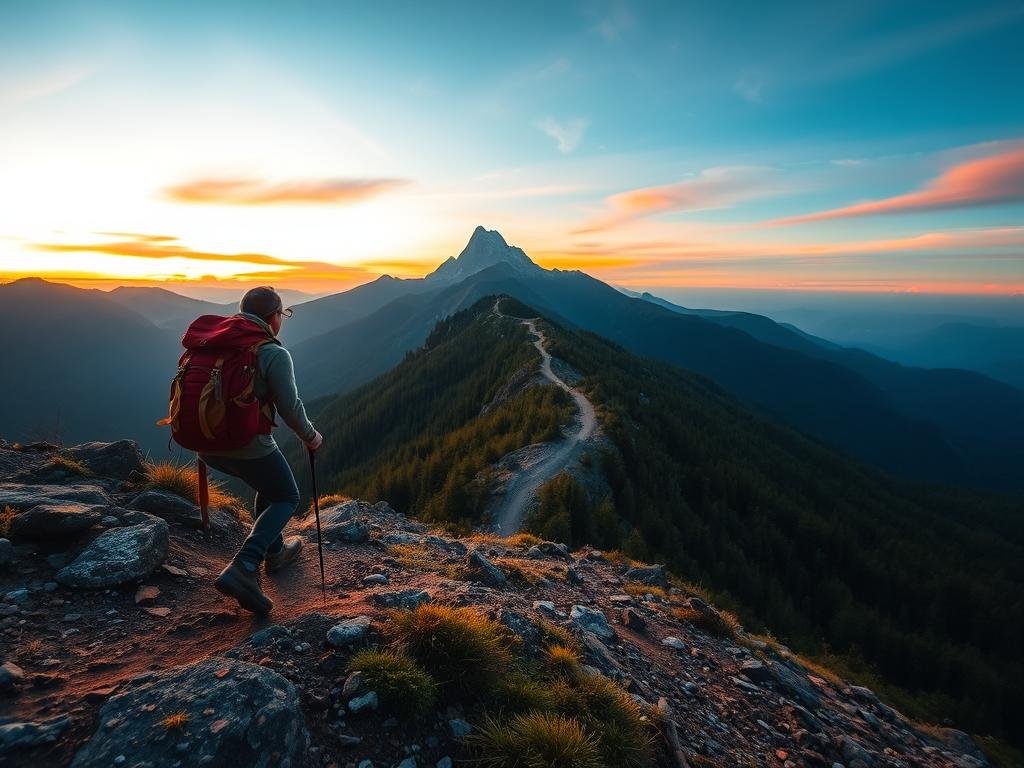
The Freedom of Hiking Alone
One of the greatest joys of hiking alone is the freedom to set your own pace. Without the constraints of group dynamics, you can fully immerse yourself in the surroundings. Kristin Addis, for example, transformed her anxiety into peace during a sunrise hike at Kawah Ijen volcano. This kind of autonomy fosters a deeper connection with nature and yourself.
Neuroscience studies show that solo nature immersion can reduce stress by 73%. This mental clarity allows you to reflect and grow in ways that group hikes often don’t offer. The idea of relying solely on your skills builds resilience and self-reliance, making every step a personal triumph.
Personal Growth on the Trail
Solo hiking is more than just a physical journey—it’s a path to personal transformation. Many people find that the solitude helps them overcome fears and embrace challenges. For instance, hikers on Nepal’s Annapurna Circuit often report feeling empowered by their decision-making autonomy.
This experience of “trail therapy” has helped countless individuals overcome life’s obstacles. Whether it’s camping in the Berkshires or trekking through the Gila Wilderness, the therapeutic effects of solo hiking are undeniable. It’s a unique opportunity to reconnect with the world and yourself, one step at a time.
Best Hikes for Solo Travelers in 2025: Complete Guide
Solo hiking offers a unique blend of adventure and self-discovery. Whether you’re exploring rugged mountains or serene forests, the experience is both empowering and transformative. In 2025, trails around the world cater to independent explorers, offering safety, beauty, and community.
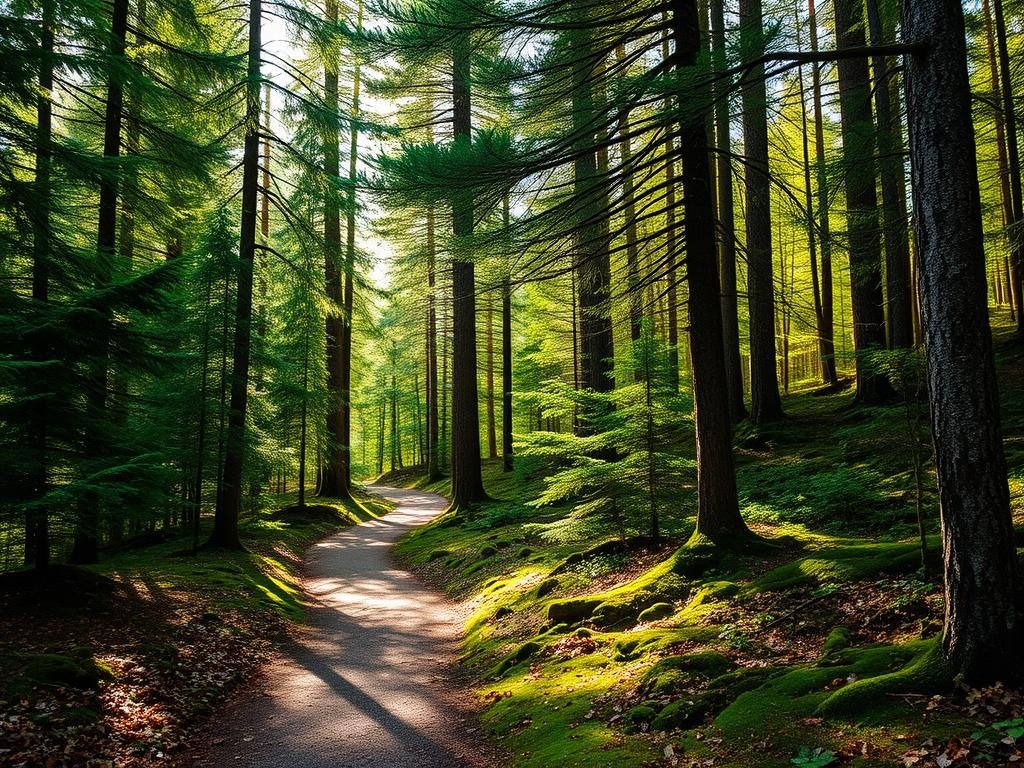
Top U.S. Trails for Solo Hikers
The U.S. boasts some of the most solo-friendly trails. Havasu Falls in Arizona is a popular choice, known for its stunning blue-green waterfalls and clear routes. Desolation Wilderness in California offers interconnected trails and sunrise vistas, perfect for those seeking solitude. Coyote Gulch in Utah features unique rock formations and shared campsites, making it ideal for solo adventurers.
International Destinations Worth Exploring
Iceland’s Laugavegur Trail is a standout, with a 78% solo hiker satisfaction rate and the reliable FÍ mountain hut system. Its open terrain and safety ranking make it a top choice for independent travelers. Peru’s Santa Cruz Trek offers a well-marked trail through the Andes, with opportunities to interact with locals. Altitude training and local guide consultations are recommended for this challenging route.
Emerging destinations like Georgia’s Mestia-Ushguli route are gaining popularity. With a GPS-tagged tea house network, it’s perfect for those seeking a blend of adventure and convenience. For more trail recommendations, check out this guide.
Safety First: Essential Tips for Solo Hikers
Safety is the cornerstone of any successful solo hiking adventure. Being prepared can make the difference between a memorable journey and a risky situation. Here are practical tips to ensure your hike is both enjoyable and secure.
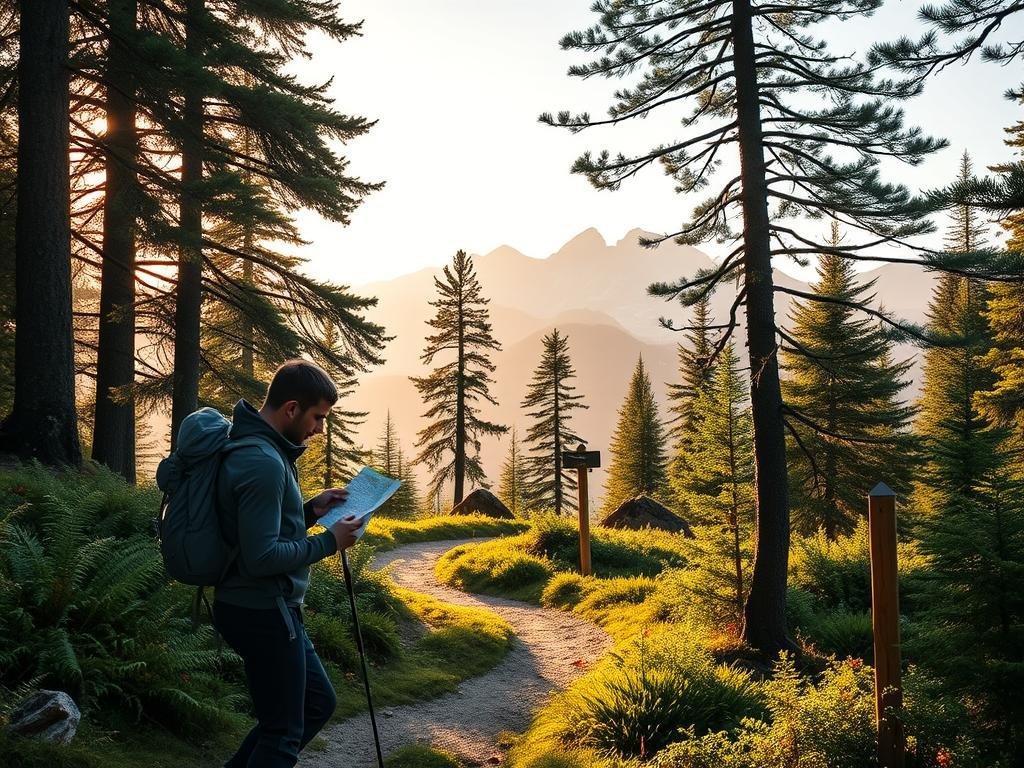
Carry the Right Safety Gear
Having the right items is crucial for any hike. A Personal Locator Beacon (PLB) or satellite phone can be a lifesaver in emergencies. Always pack a first aid kit, emergency blanket, and bear spray for added safety. Satellite-enabled smartwatches with fall detection are also becoming a popular choice for modern hikers.
Case studies show that devices like the Garmin inReach Mini have prevented multiple rescue scenarios in places like Yellowstone. These tools ensure you’re never truly alone, even on remote trails.
Tell Someone Your Plans
Before heading out, make sure to inform someone about your hiking plans. Share details like the trail you’ll be on and your expected return time. Digital check-in systems, such as the NPS Solo Hiker Registry, offer automated alerts for added peace of mind.
This simple step ensures that someone knows your whereabouts, which can be critical in case of an emergency.
Stay on Marked Trails
Sticking to marked paths is one best way to minimize risks. Data shows that 89% of emergencies occur off designated trails. Marked routes are safer, well-maintained, and less likely to lead to unexpected hazards.
If you encounter wildlife, make sure to make noise by singing or clapping to alert them of your presence. This practice keeps both you and the animals safe.
Navigating Solo: How to Stay on Course
Finding your way on a trail alone can be both empowering and challenging. With the right tools and knowledge, you can confidently explore even the most remote paths. Modern technology, combined with traditional methods, ensures you stay on track and enjoy the experience.
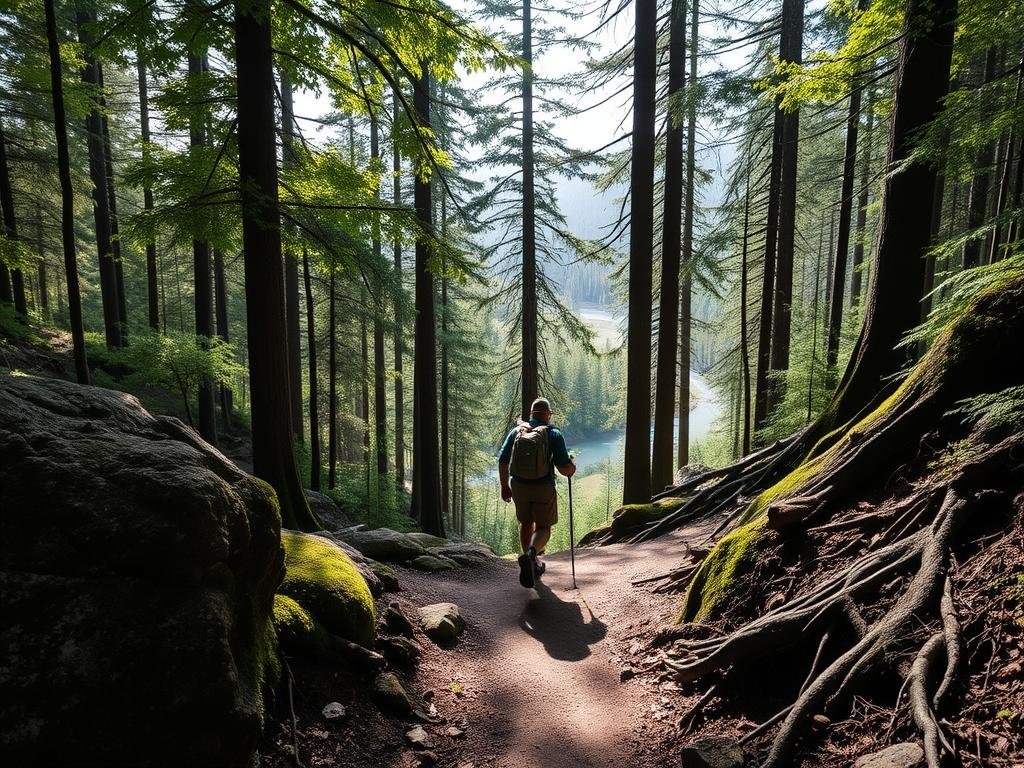
Using GPS and Maps
GPS devices like the Garmin inReach are essential for emergency communication and navigation. Apps such as AllTrails and Gaia GPS provide detailed trail maps and real-time guidance. Always carry a paper map and compass as a backup, especially in areas with limited cell coverage.
Layering your navigation methods—using GPS, a waterproof map, and an analog compass—ensures you’re prepared for any situation. Download GPS routes in advance for offline use, and practice interpreting topographic maps to identify water sources and campsites.
Recognizing Trail Markers
Trail markers are your best friends when navigating unfamiliar terrain. Iceland’s new color-coded marker system has reduced navigation errors by 62%. Learn to interpret USGS topographic map symbols to stay oriented and locate key features like water sources and camp zones.
Augmented reality (AR) navigation tools, such as EchoPeak glasses, project trail markers in real-time, offering a futuristic way to stay on course. For more trail recommendations, check out this guide on top hiking trails in the US.
Packing Light: Essential Gear for Solo Hikers
Packing efficiently is a skill every hiker should master for a seamless adventure. The right items ensure you’re prepared without being weighed down. Whether you’re planning a day hike or a multi-day trek, smart packing is key to staying comfortable and safe.
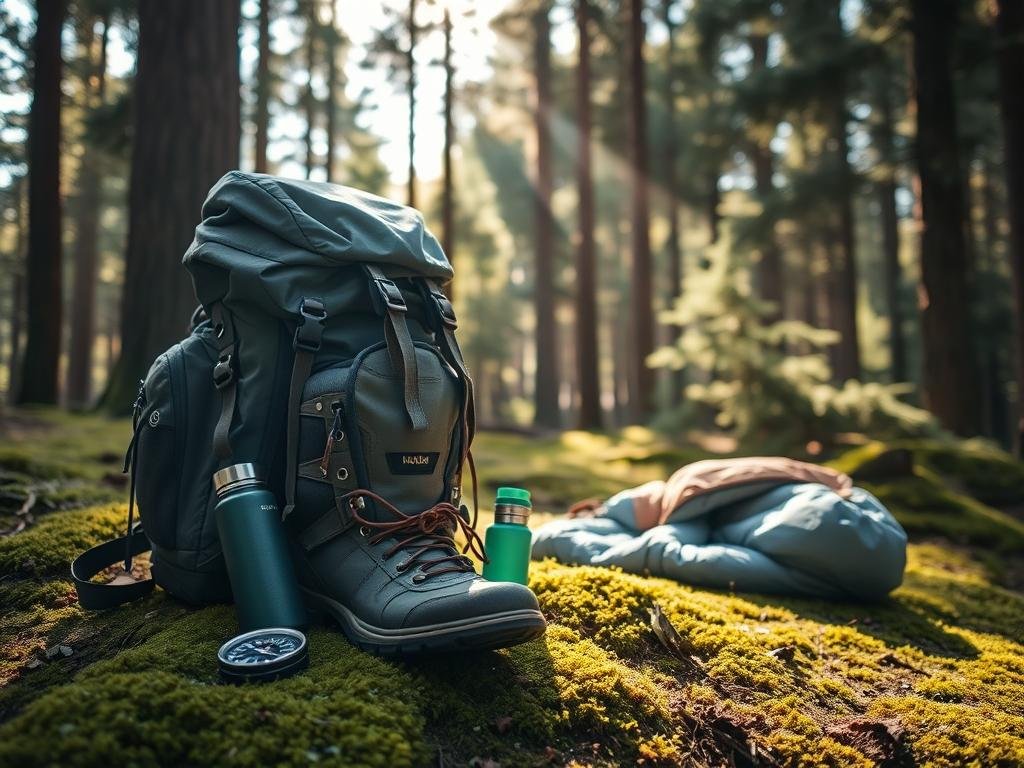
Must-Have Items for Day Hikes
For day hikes, focus on lightweight and functional gear. A reliable bag like the Atom Packs Pulse (23.2 oz) keeps your essentials organized. Carry a Platypus QuickDraw water filter (2.2 oz) to ensure clean drinking water. Don’t forget calorie-dense snacks like energy gels for quick fuel.
Navigation tools are crucial. The Garmin inReach Mini 2 (3.5 oz) provides emergency communication and GPS tracking. Pair it with a NiteCore NU25 UL headlamp (1.59 oz) for visibility after sunset.
Multi-Day Trek Essentials
Multi-day hikes require more planning. A SlingFin SplitWing Shelter (24 oz) offers lightweight protection. Pair it with a Therm-a-Rest NeoAir XLite NXT sleeping pad (13 oz) for comfort. For food, plan a 3,200-calorie daily menu using dehydrated meals and energy bars.
Trekking poles like the Black Diamond Distance Carbon FLZ (11.85 oz) double as tent supports and tinder splitters. Use smart packing cubes with RFID blocking to keep valuables safe and organized.
| Item | Weight | Purpose |
|---|---|---|
| Atom Packs Pulse Backpack | 23.2 oz | Organization and storage |
| Platypus QuickDraw Water Filter | 2.2 oz | Clean drinking water |
| Garmin inReach Mini 2 | 3.5 oz | Navigation and emergency communication |
| SlingFin SplitWing Shelter | 24 oz | Lightweight protection |
| Therm-a-Rest NeoAir XLite NXT | 13 oz | Comfortable sleeping pad |
By focusing on lightweight and multi-use gear, you can reduce your pack weight to 18-22 lbs for a 3-day trek. This approach ensures you’re prepared for the trail without unnecessary burden.
Choosing the Right Footwear
Your footwear can make or break your hiking experience, especially when you’re on your own. The right boots ensure comfort, safety, and confidence on the trail. With advancements in technology and design, finding the perfect pair has never been easier.
Breaking in Your Boots
Properly breaking in your boots is essential to avoid discomfort and blisters during long hikes. REI fitting experts recommend a 30-day break-in schedule, starting with short walks and gradually increasing the time spent in them. Kristin’s blister prevention methods, such as using moisture-wicking socks, have proven effective for many hikers.
Foot scanning apps now match 3D foot shapes to ideal boot models, ensuring a perfect fit. This technology reduces the risk of common issues like heel slippage and toe cramping, making your hiking experience more enjoyable.
Waterproof vs. Breathable
When choosing boots, consider the balance between waterproofing and breathability. GORE-TEX and eVent membranes are industry standards, offering reliable protection against wet conditions. Newer technologies like HydroSeal XT provide enhanced waterproofing without sacrificing breathability.
For rocky or wet terrains, Vibram soles are known for their durability and traction. In Iceland, waterproof boots are a necessity due to unpredictable weather, making them a top choice for hikers.
| Feature | GORE-TEX | eVent | HydroSeal XT |
|---|---|---|---|
| Waterproofing | Excellent | High | Superior |
| Breathability | Good | Excellent | High |
| Durability | High | Moderate | High |
By selecting the right boots and breaking them in properly, you can ensure a comfortable and safe way to explore the trails. Whether you’re hiking through rain or rocky terrain, the right footwear makes all the difference.
Weather Preparedness: What You Need to Know
Weather can be unpredictable, but preparation makes all the difference. Whether you’re hiking for a day or a week, understanding the forecast and dressing appropriately ensures a safe and enjoyable experience. From sudden storms to temperature swings, being ready for changing conditions is essential.
Checking Forecasts
Before hitting the trail, always check the weather forecast. Hyperlocal apps like Climacell offer predictions with a 0.5-mile resolution, giving you precise updates for your exact location. This is especially useful in places like Iceland, where weather changes rapidly and can catch hikers off guard.
Set aside time to review forecasts multiple times before your hike. This helps you plan for potential rain, snow, or extreme temperatures. Apps like Weather Underground also provide hourly updates, ensuring you’re always informed.
Layering for All Conditions
Layering is the key to staying comfortable in any weather. A 7-layer system, using merino wool and synthetic blends, works for temperatures ranging from -20°F to 70°F. Start with a moisture-wicking base layer, add an insulating mid-layer like the Patagonia Nano Puff, and finish with a waterproof outer shell.
New materials like HeiQ Smart Temp outperform traditional fleece by adjusting insulation based on body temperature. For emergencies, carry a bothy bag shelter to protect against sudden storms. This lightweight option provides instant protection when you need it most.
Here’s a quick list of essential layering items:
- Moisture-wicking base layer
- Insulating mid-layer (e.g., Patagonia Nano Puff)
- Waterproof outer shell
- Bothy bag shelter
By staying informed and dressing smartly, you can tackle any weather challenge with confidence. Preparation ensures that your hike remains safe and enjoyable, no matter what nature throws your way.
Wildlife Encounters: Staying Safe
Encountering wildlife is a thrilling yet potentially risky part of hiking. Whether you’re in bear country or dealing with smaller critters, knowing how to handle these situations ensures a safer and more enjoyable experience. Preparation and awareness are key to minimizing risks and making the most of your adventure.
Bear Safety Tips
In areas like Glacier National Park, bear encounters are a real possibility. Bear spray is crucial for deterring aggressive attacks should an encounter occur. Always carry it in an accessible location and know how to use it. Yellowstone’s 2025 regulations now include 300-meter no-spray zones, so be aware of local rules.
Proper food storage is equally important. Use bear-proof containers like BearVault or Ursack to prevent attracting wildlife. Studies show that BearVault has a lower failure rate compared to other options. Store food away from your tent and at least 100 feet from your campsite to reduce risks.
Handling Smaller Critters
Smaller animals like rodents and snakes can also pose challenges. Preventing hantavirus from rodent encounters involves avoiding contact with droppings and keeping food sealed. When encountering snakes, stay calm and move slowly away without sudden movements.
Ultrasonic deterrent devices are becoming popular for repelling coyotes and mountain lions. These devices emit high-frequency sounds that are effective in keeping animals at a safe distance. They’re lightweight and easy to carry, making them a practical addition to your gear.
Iceland’s Unique Wildlife Safety
Iceland offers a unique advantage for hikers: no venomous species. However, Arctic foxes can be curious, so keep food secure and avoid feeding them. Understanding wildlife behavior, such as peak activity times and habitat preferences, can help you avoid unwanted encounters.
| Food Storage Option | Failure Rate | Best Use Case |
|---|---|---|
| BearVault | 2% | Multi-day hikes in bear country |
| Ursack | 5% | Lightweight trips with minimal bear activity |
By staying informed and prepared, you can enjoy the beauty of nature while minimizing risks. Whether you’re in bear country or exploring Iceland’s unique landscapes, these tips ensure a safer and more rewarding way to hike.
Mental Preparation for Solo Hiking
Mental preparation is just as important as physical readiness for solo hiking. The experience of being alone on the trail can be both rewarding and challenging. Taking the time to prepare your mind ensures a safer and more enjoyable trip. Kristin Addis emphasizes that acknowledging fears and understanding what triggers them is the first step to developing coping mechanisms.
Overcoming Fear
Fear is a natural part of solo hiking, but it can be managed. Techniques like Navy SEAL breathing can help calm panic in stressful situations. Journaling apps that track mood and energy levels are also useful for identifying patterns and staying grounded. Mindfulness exercises, such as the 5-4-3-2-1 grounding method, can reduce anxiety by focusing on the present moment.
Kristin’s personal experience shows that starting small and gradually building confidence is key. This approach fosters mental stamina and helps people feel more in control. Cognitive Behavioral Therapy (CBT) techniques, like reframing negative thoughts, can also be effective during moments of isolation.
Staying Positive on the Trail
Maintaining a positive mindset is essential for a successful hike. Thru-hiker mantras, such as “The trail provides,” remind people to trust the journey and embrace challenges. Distractions like music or journaling can enhance mindfulness and keep spirits high.
Meditation and mindfulness exercises are powerful tools for embracing solitude and reducing anxiety. Kristin’s strategies include finding joy in the freedom and peace that solitude offers, which can transform the experience into a deeply rewarding one.
| Technique | Purpose | Source |
|---|---|---|
| Navy SEAL Breathing | Calm panic | Kristin’s Strategies |
| 5-4-3-2-1 Grounding | Reduce anxiety | Mindfulness Exercises |
| CBT Techniques | Reframe negative thoughts | Psychological Benefits |
Physical Training for Long Hikes
Preparing your body for long hikes is essential to ensure a smooth and enjoyable experience. Whether you’re planning a multi-day trip or tackling challenging terrain, the right training can make all the difference. Focus on building endurance, strengthening key muscle groups, and practicing proper techniques to stay safe and confident on the trail.
Building Endurance
Endurance is the foundation of any successful hike. A 12-week training plan, which includes long hikes, strength training, and aerobic/anaerobic sessions, can help you peak at 65% of your target hike difficulty. Wearing hiking shoes and a backpack during training sessions ensures specificity, preparing your body for real-world conditions.
Training with a 30lbs backpack simulates hiking conditions, building the stamina needed for long distances. Use GPS software to plan hikes with specific elevation gains, gradually increasing the challenge as your fitness improves.
Strength Exercises for Hikers
Strength training is crucial for tackling steep inclines and uneven terrain. Focus on exercises like step-ups for leg muscles, planks for core stability, and push-ups for upper body strength. Squats, leg bridges, and calf raises also target key areas, improving overall hiking performance.
Incorporate balance exercises, such as standing on one foot on various surfaces, to enhance stability. Trekking poles can reduce strain on hips and knees, making them a valuable addition to your gear.
Injury Prevention and Recovery
Preventing injuries is just as important as building strength. IT band stretches and ankle mobility drills can help maintain flexibility and reduce the risk of strains. Warm up before strength training to prepare your muscles and joints for the workout.
Proper nutrition and hydration play a key role in recovery. Carb-loading schedules and electrolyte balance ensure your body has the fuel it needs for sustained performance.
Training Tools and Techniques
Compare training tools like weighted vests, elevation masks, and altitude tents to find what works best for you. VR training simulations can help acclimate to high altitudes and challenging terrains, providing a safe way to practice.
Gear recommendations, such as the Osprey Sirrus 24L Backpack and Montem Ultra Light Hiking Poles, can enhance your training experience. These tools ensure you’re well-prepared for the demands of long hikes.
Nutrition and Hydration
Timing your meals and hydration is critical for peak performance. Focus on carb-loading before your hike and maintaining electrolyte balance during the day. Lightweight, calorie-dense snacks provide quick energy without weighing you down.
By combining physical training, proper nutrition, and the right gear, you can confidently tackle any trail. Preparation ensures a safe and rewarding hiking experience.
Leave No Trace: Ethical Hiking Practices
Respecting nature while hiking ensures trails remain pristine for future generations. Ethical practices like leave trace principles are essential for preserving the beauty of the outdoors. By minimizing your impact and disposing of waste properly, you contribute to the sustainability of natural spaces.
Minimizing Your Impact
Staying on the trail reduces erosion by 40%, helping ecosystems recover faster. Avoid shortcuts and walk on durable surfaces like rocks or gravel. This protects fragile vegetation and prevents soil degradation.
New 2025 regulations require biodegradable toilet paper, ensuring it breaks down naturally without harming the environment. Pack out all trash, including food wrappers, to prevent attracting wildlife and maintain trail aesthetics.
Proper Waste Disposal
Proper waste disposal is crucial for protecting wildlife and ecosystems. Use cat-holes for human waste, digging 6-8 inches deep and carrying out toilet paper in a sealed bag. Waste bag systems like Restop and WAG Bags are effective for this purpose.
In Iceland, unique rules include 100-meter river buffer zones for washing dishes or clothes, preventing contamination of water sources. These practices ensure the country’s pristine landscapes remain untouched.
Here’s a list of tips for ethical hiking:
- Pack out all trash, including biodegradable items.
- Use stoves instead of campfires to reduce environmental impact.
- Respect wildlife by observing from a distance.
Meeting People on the Trail
Meeting others while hiking can enrich your journey in unexpected ways. Whether you’re looking for camaraderie or just a friendly chat, the trail often brings people together. From guided tours to chance encounters, there are many opportunities to connect with like-minded adventurers.
When to Join a Group
Joining a group can enhance your hiking experience, especially on longer routes. Popular trails like the Annapurna Circuit naturally foster connections, as hikers often share stories and tips along the way. Before joining, verify credentials and share itineraries to ensure safety and trust.
Group hikes, such as those on the Laugavegur Trek, provide a structured way to meet new people while enjoying the scenery. These trips often lead to lasting friendships and shared memories.
Respecting Others’ Space
While meeting others is rewarding, it’s important to respect personal boundaries. Noise pollution can disrupt the tranquility of the trail, so consider using headphones or observing quiet hours. Cultural norms vary globally, so be mindful of differing expectations around personal space.
In emergencies, offering assistance can be a kind gesture, but always ask before intervening. This ensures you’re helping in a respectful and appropriate way.
Solo Hiking for Women: Special Considerations
For women, solo hiking offers a unique opportunity to embrace independence while navigating specific challenges. From safety concerns to cultural norms, there are several factors to consider when planning a solo adventure. With the right preparation, women can confidently explore the outdoors and enjoy the freedom of the trail.
Safety Gear Recommendations
Safety is a top priority for women hiking alone. Personal alarms like She’s Birdie or Vantamo emit loud sounds and are easily accessible, providing an immediate way to deter threats. Pepper spray or gel options, such as SABRE products, are also recommended for added protection.
Whistles, such as the Loudest Brass Whistle, serve as emergency signals and self-defense tools. GPS devices like the Garmin InReach provide emergency communication in remote areas, ensuring help is always within reach. Always carry a first aid kit for emergencies on the trail.
Choosing Women-Friendly Trails
Selecting the right trail is crucial for a positive experience. Popular trails with emergency call boxes, such as those in Iceland, offer added security and peace of mind. Iceland’s 92% female solo hiker satisfaction rate highlights its commitment to safety and accessibility.
Here’s a list of top women-vetted trails for 2025:
- Laugavegur Trail, Iceland
- Annapurna Circuit, Nepal
- South West Coast Path, England
| Trail | Safety Features | Country |
|---|---|---|
| Laugavegur Trail | Emergency call boxes, mountain huts | Iceland |
| Annapurna Circuit | Well-marked paths, local guides | Nepal |
| South West Coast Path | Frequent checkpoints, coastal visibility | England |
GPS jewelry trends, such as discreet panic buttons in bracelets or necklaces, are gaining popularity for their convenience and effectiveness. Hygiene solutions like Pibella and Freshette urinary devices also address practical concerns, making long hikes more comfortable.
Cultural challenges, such as dress codes in conservative regions, should be researched in advance to ensure respect and compliance. By considering these factors, women can confidently embark on solo hiking adventures that are both safe and rewarding.
Budgeting for Your Solo Hiking Trip
Planning a solo hiking adventure doesn’t have to break the bank. With the right strategies, you can enjoy the outdoors without overspending. From affordable gear to budget-friendly trails, there are plenty of ways to make your trip both memorable and economical.
Saving on Gear
Investing in quality gear doesn’t mean paying full price. Programs like REI’s Re/Supply and Patagonia Worn Wear offer affordable options for used equipment. These platforms provide durable items like merino wool socks and hiking boots at a fraction of the cost, saving you money in the long run.
For those who prefer renting, platforms like Arrive Outdoors and Local Gear Hub offer gear rental services. This is a great way to access high-quality equipment without the upfront cost. Shared equipment networks, such as hiker-to-hiker lending apps, are also gaining popularity for their convenience and affordability.
Affordable Trail Options
Choosing the right trail can significantly impact your budget. Free USFS routes are an excellent alternative to paid national park trails, offering similar scenic views without the fees. The America the Beautiful pass, priced at $80, provides access to national parks for a year, making it a cost-effective choice for frequent hikers.
Hidden costs, like permit fees, are increasing by 30% in popular parks. Researching these expenses in advance helps you plan better. In Iceland, the hut system allows hikers to stay for $75 per day, a budget-friendly option compared to wild camping.
Here are some tips to save on your next trip:
- Use GasBuddy to find the best gas prices for your travel.
- Explore free resources like AllTrails and Facebook groups for affordable hiking options.
- Consider shoulder season travel to save on accommodations and avoid crowds.
By combining these strategies, you can enjoy a solo hiking adventure in any country without straining your wallet. Smart planning ensures you focus on the experience, not the expenses.
Documenting Your Journey
Capturing memories on the trail adds depth to your solo adventure. Whether through photos or journal entries, documenting your hike allows you to relive the experience and reflect on your growth. It’s a way to preserve the beauty of nature and the lessons learned along the way.
Photography Tips
Lightweight gear is essential for capturing stunning trail moments. Kristin used a mirrorless camera with a polarizing filter and a smartphone for wide-angle shots during her hike. This combination ensures versatility without adding unnecessary weight to your pack.
Smartphone pro modes can rival traditional cameras, offering features like manual focus and exposure control. GPS tagging methods, such as automating photo location metadata, help you organize and remember each shot. For social media, consider delayed posting to prevent location tracking and maintain safety.
Keeping a Trail Journal
Journaling is a powerful tool for reflecting on your trip. Kristin kept a trail journal to log her experiences and reflections on each section of the hike. Weatherproof notebooks or voice memos are practical options for preserving your thoughts in any condition.
Reflective writing prompts, such as “What surprised me today?” or “How did I overcome a challenge?” can deepen your personal growth. These prompts encourage mindfulness and help you process the time spent on the trail.
Here’s a list of tips for effective trail documentation:
- Use lightweight photography gear like mirrorless cameras or smartphone pro modes.
- Automate GPS tagging for easy photo organization.
- Choose weatherproof notebooks or voice memos for journaling.
- Incorporate reflective writing prompts for personal growth.
Conclusion
Embarking on a solo hiking journey can transform your perspective and ignite a sense of freedom. It’s a life-changing experience that builds self-reliance and offers stress relief, making it a rewarding adventure. Start with local trails to build confidence, then gradually explore more challenging routes around the world.
In 2025, advancements in technology make solo hiking safer than ever. Apps like AllTrails and essential gear like emergency beacons ensure you’re prepared for any situation. These tools allow you to focus on the beauty of nature and the joy of the journey.
Ready to plan your adventure? Check out expert trail guides for tips on gear, safety, and budgeting. As Kristin Addis says, “The trail provides” – take the first step and discover the transformative power of solo hiking.



1 Comment
Top Free Hiking Trails in the U.S. with Stunning Views · April 2, 2025 at 3:12 pm
[…] at established sites 200 feet from water sources. Follow Leave No Trace principles to protect fragile dune […]